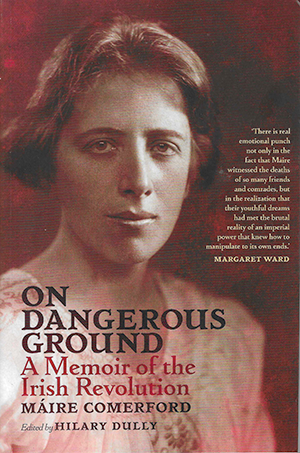ON DANGEROUS GROUND: A MEMOIR OF THE IRISH REVOLUTION
Published in Book Reviews, Book Reviews, Issue 3 (May/June 2022), Reviews, Volume 30 MÁIRE COMERFORD (ed. Hillary Dully)
MÁIRE COMERFORD (ed. Hillary Dully)
Lilliput Press
€20
ISBN 9781843518198
Reviewed by Angus Mitchell
Angus Mitchell was recently commissioned to write The Casement Memorial Statue for Dún Laoghaire and Rathdown County Council.
If this book been published ten years earlier, how might it have influenced the history written during the ‘decade of centenaries’? At the end of her life, Máire Comerford struggled, without success, to get her memoir into print. A version was deposited in UCD archives, but few historians gave it oxygen. Now, caringly published, readers can follow the logic of a revolutionary mind.
Máire Comerford (1893–1982) was the embodiment of the lost republican ideal. After witnessing the 1916 Rising, she was swept into the radical slipstream. A Cumann na mBan stalwart and fiercely anti-Treaty, she was imprisoned, survived hunger strike and was released into social isolation before being rescued by a job as an Irish Press journalist. But she never relinquished her faith in the authority of the Second Dáil. After 1969 her focus shifted north, and she became friendly with the next generation of republican resistance. If her story captures a revolutionary network, it does so by placing women unselfconsciously at the heart of the insurgency.
She was born into a well-to-do Catholic family from County Wexford; her father, a mill-owner, was friendly with Parnell and the Bartons. Her first experience of liberation came through her love of cycling. She biked everywhere between Uisneach and the four provinces. During a secretarial course in London she witnessed anti-Irish bigotry for the first time, a phenomenon that she found hard to comprehend.
A chance visit to Dublin in April 1916 brought her face to face with the risen people. After canvassing during the Sinn Féin election at the end of 1918, she was employed as a research assistant by the historian and anti-colonial nationalist Alice Stopford Green, and lived at her house at 90 St Stephen’s Green. During the next two years, the sun-soaked dining room at No. 90 was turned into an informal university and debating chamber for those involved in the independence struggle.
This access to the privileged high table of the revolutionary matrix intersected strategically with her work for Cumann na mBan—gathering intelligence and running errands. It makes Comerford’s insights an essential source. There are brilliant flashes into how gender was deployed to subvert authority: the women selling apples and flowers whose ‘capacious aprons’ could be used to hide a smoking revolver or undischarged bomb. The memoir is filled with vivid sketches of many of the revolutionary women of her generation, including faces that have been wiped from more recent narratives: Gobnaít Ní Bhruadair, Sighle Humphreys, Dulcibella Barton, Elizabeth Bloxham, Máire MacSwiney, Kate O’Callaghan, Dorothy Macardle, Charlotte Despard, Min Ryan and Lilly O’Brennan. She said of Molly Childers that she had ‘more influence in the background’ of the events of the War of Independence than any other woman. Who would have thought that? Of the men, we gain valuable new insight into Robert Brennan, John Chartres, the Etchinghams, Rory O’Connor and Fr Michael O’Flanagan.
Beyond the emotion, excitement and solidarity of the War of Independence, the memoir reveals the covert work of state-building that was happening in the background to events within a half-mile radius of No. 90. Those initiatives included Cumann Leigheacht an Phobail, the School of Irish Learning, and the critically important Irish White Cross, which galvanised transatlantic solidarity around humanitarian concern. Another of Comerford’s tasks was to escort English visitors to trouble spots to bear witness to the military reprisals and atrocities. The recollection of her journey with Ethel Snowden demonstrates the ignorance and distortions circulating in England about the Irish war.
Comerford describes typing out the agreed words for the Truce in July 1921. There followed months of talks, delegations and pacts that ended in ‘the Treaty’, followed quickly by ‘the Split’. In the last third of the memoir, we are brought face to face with the emotion and pain of the Civil War. Descriptions of the battle of the Four Courts and the siege of the Hamman Hotel provide insight into Comerford’s unquenchable commitment, leading to her imprisonment in Mountjoy and, following her release, her secret mission to America.
Comerford’s memoir is informed by an indefatigable devotion to Ireland and the hopes for deep social transformation. She never doubted for a moment that the Treaty was an act of treason: an imperial solution to England’s Irish problem. Partition, part of the tool kit of imperial control, was one more outrage that denied for another century any chance of real peace or conciliation. She stood faithful to her belief in the sovereignty expressed by the Irish people in the elections of the First and Second Dáils.
Comerford takes the occasional shot at historians. She derides accounts of those individuals involved in the anti-Treaty side who were ‘outrageously misrepresented’ in the histories written in the decades after the revolution. She suggests at one point that there should be a ‘code of conduct’ for historians—there’s still time!
The high production values of Lilliput Press complement the sympathetically edited and annotated work of Hilary Dully. Better known as a documentary film-maker, Dully is related through marriage to Máire Comerford. It would be hard to select a memoir of the revolutionary period that reads as well and conveys with such honesty the spirit of that time. This is a book that will sit alongside Mary Colum’s Life and the dream or Ernie O’Malley’s On another man’s wound and becomes a classic in the very hour of its launch. Comerford’s story can no longer be overlooked.
















